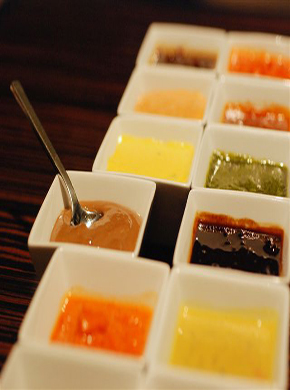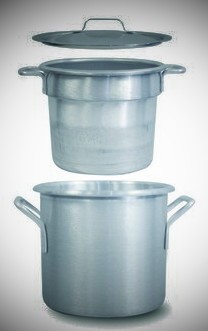Chef's Corner with Chef Brian Roland

‘Mother Sauces’
Cooking can be a fun filled experience in the kitchen which allows the home cook to be creative and speak from their heart. There is not a day that goes by that I don’t feel that passion and love for ingredients when I step foot in the restaurant. I know you’ve seen me write before that cooking has no rules, to be free and do what comes naturally, but sometimes it is beneficial to follow some guidelines that have been developed over the past few decades to enhance your cooking experience.
 Many of these guidelines and original recipes were developed by a French chef dating back to the 19th century named Antonin Carême. He is credited with developing a variety of sauces that all stemmed from a series of 4 focused sauces. These became known as the
Many of these guidelines and original recipes were developed by a French chef dating back to the 19th century named Antonin Carême. He is credited with developing a variety of sauces that all stemmed from a series of 4 focused sauces. These became known as the  "Mother Sauces", and were used as a base sauce to create hundreds of derivatives. In the 20th century, Auguste Escoffier updated these sauces and added a 5th mother sauce. Today, they are recognized as the following 5 sauces:
"Mother Sauces", and were used as a base sauce to create hundreds of derivatives. In the 20th century, Auguste Escoffier updated these sauces and added a 5th mother sauce. Today, they are recognized as the following 5 sauces:
Bechamel – a milk based sauce that is thickened with a roux (clarified butter and flour). This sauce is named after its creator Louis XIV's steward, Louis de Béchamel. Considered the king of all sauces, and often called a cream sauce because of its consistency, this sauce is most often used in all types of dishes. Examples may include crème, mornay & soubise. Velouté – a sauce made with white stock and roux. It is most often made with chicken or fish stock, and can sometimes be enriched with egg yolks or cream. Examples would include sauce allemande, white bordelaise, and supreme. Espagnole or Brown Sauce – a brown stock based sauce often made with a rich meat stock (veal, beef, or lamb) a mirepoix of vegetables (carrots, celery and onion), a brown roux (the roux must be cooked until it changes color) fresh herbs, and tomato paste. Examples would include sauce bordelaise, chasseur, madiera, chateaubriand, and a refined Demi glace. Tomato Sauce – a tomato based sauce normally made with onion, tomato & fresh herbs. Examples would include marinara, and spaghetti sauce. Hollandaise/Emulsions – sauces that are emulsified, meaning a fat and a liquid made into one coalescent mixture. This can be as basic as a vinaigrette, or more in depth such as a hollandaise or mayonnaise.
Sauce can be defined as a flavorful liquid or semi solid liquid that is served on or alongside of food. In French Cuisine, sauces can date back all the way to the middle ages. Back then, when refrigeration was not available, the shelf life on food was much shorter. Sauces were used to mask the foods’ poor quality, and give the plate a more pleasing taste. Over the years, sauces became more popular for their flavor, and chefs began using creativity to wow the palate with their skills.
Today, all 5 mother sauces or "grand sauces," are still used as a foundation to assist chefs and cooks in the kitchen. Pay close attention to the quality of ingredients going into the sauce, as it is very important to the success of the final sauce’s taste. I learned that from my first chef and mentor, Lyon, France native Chef Patrick Verré…"put crap in, get crap out1" That phrase has stuck with me for years, and it couldn’t be more true with this very important element of the plate. Selection of good quality wines and vegetables can be new for some people, so consult with your local store manager to get answers to any of your questions.
 Roux can be an intimidating process, so lets take a closer look at the components and how they are prepared. Roux is simply a cooked mixture of equal parts wheat flour (use all purpose) and a fat, traditionally clarified butter. First melt the fat in a pot or pan, then slowly add the flour being sure to whisk it until the flour is completely incorporated. It is also important to cook the roux until there is no longer a raw flour taste, and can continue cooking until the desired color has been achieved. The color can range from white to dark brown depending on how long it is left on the heat. The end result is a flavoring, coloring, thickening agent that can enhance the flavor and consistency of sauces, soups and stocks.
Roux can be an intimidating process, so lets take a closer look at the components and how they are prepared. Roux is simply a cooked mixture of equal parts wheat flour (use all purpose) and a fat, traditionally clarified butter. First melt the fat in a pot or pan, then slowly add the flour being sure to whisk it until the flour is completely incorporated. It is also important to cook the roux until there is no longer a raw flour taste, and can continue cooking until the desired color has been achieved. The color can range from white to dark brown depending on how long it is left on the heat. The end result is a flavoring, coloring, thickening agent that can enhance the flavor and consistency of sauces, soups and stocks.
 Here are some tips for a more successful sauce. When using a roux to thicken, be sure to constantly stir during cooking to prevent lumps. If lumps remain, attempt to use a whisk to break them up….if that doesn’t work, strain the sauce through a strainer, and then adjust seasoning. When cooking an egg thickened sauce, be sure to stir the sauce over a double boiler over medium heat (not boiling) to lightly and slowly cook the egg. Be careful not to let the sauce boil, as the eggs will curdle and destroy the consistency of the sauce. Also make sure the water in the double boiler doesn’t touch the bottom of the bowl, this will prevent the transfer of heat from happening too fast and potential scrambling the sauce.
Here are some tips for a more successful sauce. When using a roux to thicken, be sure to constantly stir during cooking to prevent lumps. If lumps remain, attempt to use a whisk to break them up….if that doesn’t work, strain the sauce through a strainer, and then adjust seasoning. When cooking an egg thickened sauce, be sure to stir the sauce over a double boiler over medium heat (not boiling) to lightly and slowly cook the egg. Be careful not to let the sauce boil, as the eggs will curdle and destroy the consistency of the sauce. Also make sure the water in the double boiler doesn’t touch the bottom of the bowl, this will prevent the transfer of heat from happening too fast and potential scrambling the sauce.
When making a cold emulsion such as a vinaigrette or mayonnaise, be sure to add the fat slowly. This will allow the emulsion to take place and  the liquid to accept the fat while whisking. If the fat is added too fast, the sauce will "break," leaving a pool of oily mess with a destroyed look and flavor.
the liquid to accept the fat while whisking. If the fat is added too fast, the sauce will "break," leaving a pool of oily mess with a destroyed look and flavor.
I hope this helps you explore the exciting preparations of sauce making. Try adding different herbs and spices or cook with a different wine of your choice. Remember, sauces are to enhance a dish, so always be sure that the main protein, vegetable and/or starch is great quality and purchased from a reputable supplier. Email me if you have any questions, or would like to share ideas or experiences via Contact with 'Questions for Chef Brian' in the subject line.
For now, Good Luck and Good Eating!
~Chef Brian


